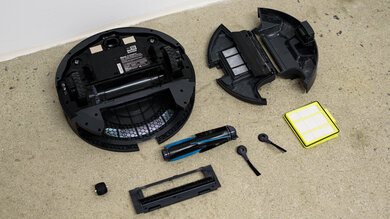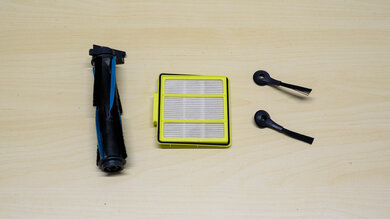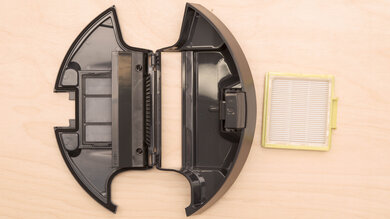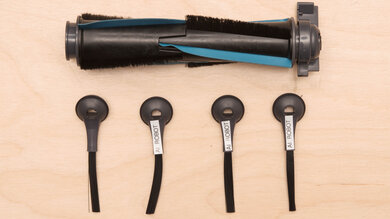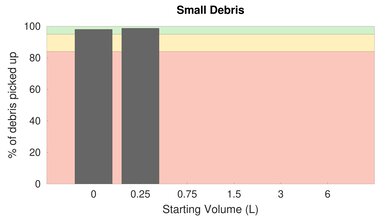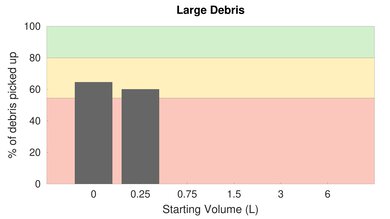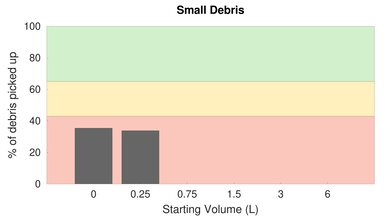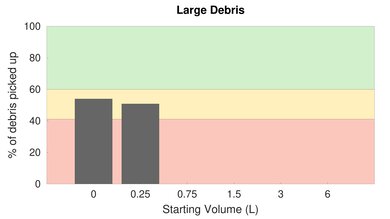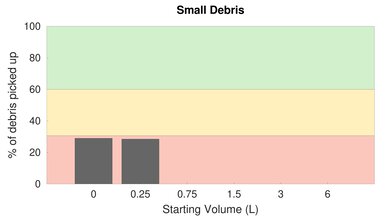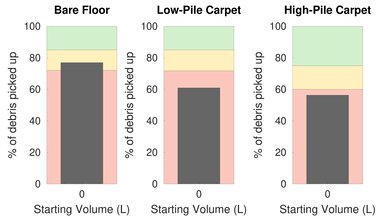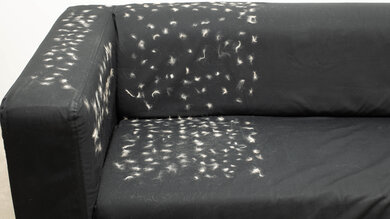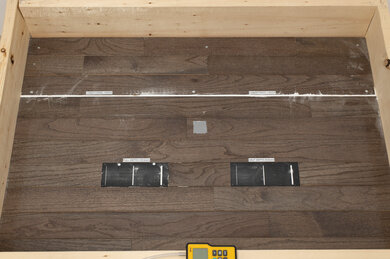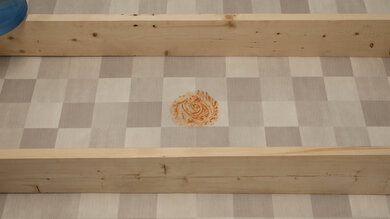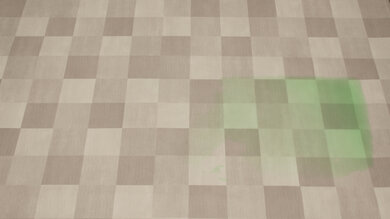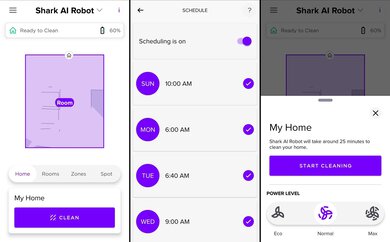The Shark AI Robot is a robot vacuum with relatively advanced automation features. It sits near the middle of Shark's range of robot vacuums, with a relatively sophisticated laser navigation sensor that allows for smart pathing and object avoidance, features not found on the entry-level Shark ION Robot RV700 Series. However, unlike the newer Shark AI Ultra Robot, it doesn't have a LIDAR mapping sensor and isn't compatible with a self-emptying docking station.
Our Verdict
The Shark AI Robot is a satisfactory option for bare floors. It can easily pick up small debris, but pet hair can get caught in the brushroll, and it has trouble clearing bulky debris as the dirt compartment fills up. It also has many parts that need regular cleaning or replacing, so recurring costs can add up over time.
-
Great maneuverability.
-
Easily clears small debris.
-
Fantastic battery performance.
-
Wide range of automation features.
-
Large debris can get caught in the vacuum's intake opening.
-
Pet hair gets caught in the brushroll.
-
Many parts need regular cleaning.
-
High recurring costs.
The Shark AI Robot is a mediocre option for low-pile carpet. It can pick up a fair amount of large debris, but it struggles to clear very fine debris. Pet hair can also cling to the brushroll rather than get sucked up. This vacuum also has many parts that need regular cleaning or replacing. Still, it feels well-built and does a great job maneuvering itself. It also has a wide range of automation features.
-
Great maneuverability.
-
Fantastic battery performance.
-
Wide range of automation features.
-
Struggles to pick up small debris and pet hair.
-
Many parts need regular cleaning.
-
High recurring costs.
The Shark AI Robot is passable for vacuuming high-pile carpet. It does a mediocre job handling solid debris, while pet hair can get stuck on its brushroll. Also, there are quite a few parts that need regular cleaning. On the upside, it's well-built and has great maneuverability. Using its companion app also grants you access to a fairly wide variety of automation functions, though it's worth noting that the app isn't especially user-friendly.
-
Great maneuverability.
-
Fantastic battery performance.
-
Wide range of automation features.
-
Sub-par overall performance on high-pile carpet.
-
Many parts need regular cleaning.
-
High recurring costs.
The Shark AI Robot is a poor choice for pet owners. Regardless of the surface it's on, pet hair tends to get stuck to its brushroll instead of being sucked into its dirt compartment. It doesn't have an allergen-trapping HEPA filter either, with some fine allergens like pet dander escaping from its exhaust. This vacuum also has many parts that need regular cleaning and incurs high recurring costs. Thankfully, it feels pretty sturdy and operates pretty quietly, which is good if your pet is sensitive to loud noises.
-
Great maneuverability.
-
Wide range of automation features.
-
Pet hair gets caught in the brushroll.
-
Many parts need regular cleaning.
-
No HEPA filter.
-
High recurring costs.
The Shark AI Robot is a robot vacuum and isn't designed to clean stairs.
The Shark AI Robot is a robot vacuum; you can't use it to clean inside your car.
The Shark AI Robot is a robot vacuum and isn't suitable for workshop cleaning.
- 6.8 Bare Floor
- 6.5 Low-Pile Carpet
- 6.0 High-Pile Carpet
- 4.3 Pets
- 5.7 Stairs
- 4.7 Cars
- 4.1 Workshop
Changelog
-
Updated Dec 03, 2024:
We've added text to the Airflow box.
- Updated Nov 07, 2023: Converted to Test Bench 0.7.
- Updated Oct 25, 2023: We've added a link to the Shark Matrix Robot in the 'Battery' section to provide an alternative that recharges faster.
- Updated Mar 17, 2023: We've updated the text in the review to account for the new tests and scoring methodology in Vacuum Test Bench 0.5 and Vacuum Test Bench 0.6.
- Updated Feb 21, 2023: We've changed the full product name to 'Shark AI Robot' in order for the review to encompass all model variants. We've also added the AV2001 variant to the 'Differences Between Variants' section.
Check Price
Differences Between Sizes And Variants
There are two variants of the Shark AI Robot, though they only differ in terms of included accessories, and we don't expect there to be any notable differences in performance. We tested the RV2001 model, and you can see its label here.
| Model Code | Included Accessories | Color | Notes |
| AV2001 | 4x side brushes, 1x filter | Grey | Updated version of the RV1001 |
| RV2001 | 4x side brushes, 2x filters | Black/Silver |
If you come across another variant of this vacuum that hasn't been mentioned, please let us know in the discussions, and we'll update this review.
Compared To Other Robot Vacuums
The Shark AI Robot is a robot vacuum with alright overall performance, sitting squarely in the middle of the vacuum market. Its laser mapping system results in much better maneuverability and faster room mapping than entry-level random-pathing models, which move around your home by bouncing off walls and obstacles. However, it's a little lacking in features compared to newer models with faster LIDAR mapping, compatibility with self-emptying base stations, and, in some cases, mopping attachments.
If you're looking for an alternative, check out our recommendations for the best robot vacuums, the best robot vacuums for carpet, and the best robot vacuums for pet hair.
The Shark Matrix Robot is better overall than the Shark AI Robot. The Matrix is compatible with a self-emptying base station, delivers better overall debris pickup on a variety of surface types, and recharges faster.
The Shark AI Ultra Robot is better than the Shark AI Robot. The AI Ultra is self-emptying compatible, does a better job of clearing debris from cracks, performs better on bare floors, has an easier time dealing with pet hair, and has a LIDAR mapping system, which allows for quicker room mapping, even in the dark. Conversely, the AI Robot has fewer parts needing regular cleaning, incurs lower recurring costs, and offers better overall coverage despite its simpler navigation system, as it won't identify everyday objects as hazards to avoid.
The Shark AI Robot and the Shark IQ Robot AV992 Series have different strengths, and which you prefer depends on your needs. The AI Robot has better battery performance and offers more advanced automation features, like schedule programming for individual rooms. However, the AV992 delivers much better performance on bare floors.
The Shark IQ Robot is a better robot vacuum than the Shark AI Robot. While both robot vacuums are well-built, the IQ Robot has superior overall performance on all surface types. However, the AI Robot has fewer recurring costs and has better maneuverability as well as a longer battery life.
The Roborock Q5 is better than the Shark AI Robot. The Roborock can be bundled with a self-emptying dock that reduces hands-on maintenance requirements, has an automatic surface adjustment feature, and does a better job of handling pet hair. The Mi Home app is also far more intuitive than the SharkClean app and has a broader range of features, including manual directional control and 3D map viewing.
The Wyze Robot Vacuum is better than the Shark AI Robot. The Wyze's LIDAR mapping sensor allows for quicker, more precise room mapping. It has a considerably better companion app, though the Shark does offer a similarly broad suite of automation features, like support for no-go zones. The Wyze also feels better built, is more effective in clearing away pet hair, and is easier to maintain. However, the Shark has a larger dustbin and a longer battery life.
The iRobot Roomba i8+ is better than the Shark AI Robot. The iRobot is better built, is easier to maintain, does a better job of handling pet hair, and has a significantly better companion app. It also comes with a self-emptying dock that reduces hands-on maintenance requirements and an automatic surface detection system. That said, the Shark has a longer maximum battery life.
The Roborock S7 MaxV is a much better robot vacuum than the Shark AI Robot, though that isn't overly surprising given the substantial price discrepancy between the two. The Roborock has a more advanced dual-sensor navigation system, which allows it to map out its coverage area and spot low obstacles. It also features an ultrasonic mopping system that's impressively effective in scrubbing away stains, not to mention a far more potent suction motor, resulting in better debris pickup. Lastly, the Roborock is fully compatible with the brand's Empty Wash Fill Dock, which automatically empties the vacuum's dustbin, refills its water tank, and washes its mopping pads, making for a mostly hands-off ownership experience.
The Shark AI Robot is better than the Shark ION Robot RV700 Series. The AI feels better built, incurs lower recurring costs, and maneuvers itself far more effectively. Its more sophisticated mapping system lets you set up virtual boundary markers to keep it out of certain areas. Meanwhile, the RV700 Series clears more debris on bare floors and high-pile carpets, though the AI does do a better job on low-pile carpets.
The Shark AI Robot and the iRobot Roomba j7 each have strengths, so one may suit you better than the other, depending on your needs. The Shark incurs lower recurring costs, has a longer maximum battery life, and delivers superior performance on bare floors and low-pile carpet. Meanwhile, the iRobot charges much faster, feels better built, clears more debris on high-pile carpet, maneuvers itself more effectively, and has more advanced automation capabilities, most notably its self-emptying compatibility and hazard recognition feature.
The Shark EZ Robot Self-Empty and the Shark AI Robot both have advantages, meaning one may suit you better depending on your own needs. The EZ has a much greater dirt compartment capacity because of its external dustbin and delivers superior performance on low- and high-pile carpets, especially when dealing with pet hair. Meanwhile, the AI incurs fewer recurring costs, has fewer parts that need regular cleaning, and maneuvers over obstructions like electrical cords with less difficulty. In addition, you can use its companion app to set up virtual boundary lines that the AI won't cross.
The Roborock S7 is better for more uses than the Shark AI Robot. The Roborock is better built, has fewer parts requiring regular maintenance, has a larger dustbin, and clears more debris across all surface types. Unlike the Shark, the Roborock also comes with a mopping attachment for bare floors.
The Roborock S6 MaxV is better for most purposes than the Shark AI Robot. The Roborock delivers better performance on bare floors and high-pile carpets. It can automatically adjust its suction power when cleaning carpets and has a unique 'Reactive AI' feature for detecting and avoiding obstacles. However, the Shark has a longer maximum battery life and recharges more quickly. It also delivers better performance on low-pile carpets.
The Shark AI Robot and the iRobot Roomba 694 each have advantages, so one may suit you better than the other, depending on your needs. The Shark has a longer battery life, maneuvers itself more effectively, has a wider array of automation features, and clears more debris on low-pile carpets. However, the iRobot feels better built, has fewer parts requiring regular maintenance, charges much faster, and is slightly more effective on high-pile carpets.
The iRobot Roomba 960 is a better robot vacuum than the Shark AI Robot. The iRobot feels better built and offers better performance on all surface types. It also has better maneuverability. However, the Shark has longer maximum battery life.
The Roborock S4 Max is better than the Shark AI Robot. The Roborock feels better built, has fewer parts requiring regular maintenance, has a much larger dustbin, and performs notably better on bare floors and high-pile carpets. Meanwhile, the Shark charges faster.
The iRobot Roomba i3 is a better vacuum than the Shark AI Robot. They perform fairly similarly overall, but the iRobot does a much better job on bare surfaces and high-pile carpets. It's also better built and has an automatic dirt disposal feature. On the other hand, the Shark has a better performance on low-pile carpets and lower recurring costs.
The iRobot Roomba 981 is a better robot vacuum than the Shark AI Robot. The iRobot feels better built and is easier to maintain. It also performs better on all surface types and has superior maneuverability. However, the Shark has a longer battery life, and you can set boundary markers for it via its companion app.
The Roborock S6 is a better robot vacuum than the Shark AI Robot. The Roborock is better built, is easier to maintain, and has a mopping feature, although we don't currently test it. It also offers better performance on all surface types. However, the Shark has a slightly better battery performance.
The Roborock S4 and the Shark AI Robot have different strengths, and depending on your preferences, you may prefer one over the other. The Roborock is better built, easier to maintain, and has a significantly better performance on bare floors. However, the Shark can climb onto high-pile carpets to clean it, though it still has sub-par performance on this surface type.
The iRobot Roomba E5 and the Shark AI Robot both have advantages, so one may suit you better than the other, depending on your needs. The iRobot is better built, has fewer parts that need regular cleaning, has an allergen-trapping HEPA filter, and performs slightly better on carpeted surfaces. Conversely, the Shark has a wider array of automation features, maneuvers itself more effectively, clears more debris on bare floors, and incurs lower recurring costs. It also has a much longer battery life, though the iRobot charges substantially faster.
The iRobot Roomba S9 is better than the Shark AI Robot. The iRobot is better built, has fewer parts requiring regular maintenance, charges much faster, has an automatic surface detection system, maneuvers itself more effectively, and clears more debris on bare floors and low- and high-pile carpets. Conversely, the Shark incurs lower recurring costs and has a longer maximum battery life.
The Shark AI Robot is better than the iRobot Roomba 675. The Shark has a more advanced navigation system that allows for room mapping and smart-pathing. It also incurs lower costs of ownership than the iRobot, has a larger dustbin, lasts longer on a charge, and does a better job of maneuvering itself. On the other hand, the iRobot feels slightly sturdier, recharges a lot faster, and does a better job of dealing with debris in cracks, like grout lines on a tile floor.
The Neato Botvac D7 is a better robot vacuum than the Shark AI Robot. The Neato is better built, is significantly easier to maintain, and has better performance on all surface types. However, the Shark has fewer recurring costs and better maneuverability.
The iRobot Roomba i7 is a better robot vacuum than the Shark AI Robot. The iRobot is better built, easier to maintain, and can automatically empty its dust bin into a larger external dirt compartment. It also performs significantly better on low and high-pile carpets and has better maneuverability. However, the Shark has fewer recurring costs, and its battery performance is better. It also does a better job on bare floors and comes with a remote control.
Test Results
The Shark AI Robot feels well-built. Its hard plastic construction has a matte finish, and its main drive wheels have rubber treads. It has a fairly premium appearance and feels quite sturdy overall, though its clear plastic dustbin is a little fragile.
Out-of-the-box assembly is quite simple, requiring only that you snap its two side brushes into place and plug in its docking station.
This vacuum has many parts that need periodic cleaning.
- Dustbin: You can easily remove this part by pressing its release button. An anti-tangle comb is attached to the dustbin to collect any hair that might get sucked in, reducing the chances of hair clogging up the vacuum. However, this plastic comb does take up quite a bit of space and makes it hard to completely clean every last nook and cranny of the dustbin, even after you've emptied it over a trash bin.
- Pre-motor filter: The pre-motor filter is located inside the dirt compartment and can be pulled out by its release tabs. You can tap this part over your garbage to dislodge dirt and dust after each use. You can also rinse it with water once a month if needed.
- Brushroll: You need to remove the brushroll cover underneath the vacuum to access this part. No specific maintenance interval is given by the manufacturer, but make sure to remove any tangled hair or stuck-on debris regularly. The fins on the brushroll aren't especially effective in preventing hair from getting tangled around it, and you'll still probably need to cut away some longer strands with a pair of scissors.
- Side brushes: You can pull the side brushes out of their sockets without the need for any tools. You should check them weekly and clean them as needed by removing hair or debris. You can also wipe them with a damp cloth.
- Drive wheels: The drive wheels and their housing needs periodic cleaning, as necessary. You should rotate the wheels while cleaning dirt and debris.
- Front wheel: You can pull the front wheel from its housing, but this can take quite a bit of effort, so you'll probably need a pair of pliers. You should clean it periodically and take it out of its housing to clear it of debris.
- Sensors and charging pads: The sensors and charging pads are on both the robot and its charging station. You should clean them regularly by dusting off the sensors and pads with a dry cloth.
Any part you can rinse under water should be left to dry for at least 24 hours before being reinstalled.
This vacuum incurs many recurring costs.
- Pre-motor filter: There isn't a specified replacement time for this filter, as it's washable. However, the manual specifies that you should check the manufacturer's website for replacements if necessary. You can buy a replacement from Shark's website here.
- Brushroll: You should replace the brushroll every six to 12 months, depending on your usage. You can buy a replacement from Shark's website here.
- Side brushes: You should replace the side brushes if bent or damaged. You can buy a four-pack of replacements from Shark's website here.
A replenishment kit is also available and comes with:
- 1x Filter
- 1x Brushroll
- 4x Side brushes
This vacuum is outstandingly easy to store. It can dock itself to its charging station, which doesn't take up much space. While the robot is a bit taller than the Shark IQ robot, it's still pretty compact.
The dirt compartment is somewhat small. It holds less debris than the Shark IQ Robot and doesn't have a visible indicator to let you know how full it is.
The range is limited only by the room left in its dirt compartment and the remaining battery life. However, like any robot vacuum, it can't go up or down stairs.
This vacuum is pretty portable. It isn't very heavy, but it doesn't have a carrying handle to make it easier to carry from one room to another.
The battery performance is fantastic. In its high-suction 'Max' setting, it provides roughly 90 minutes of continuous runtime. Using it in its more energy-efficient 'Eco' suction power setting extends its maximum runtime to over 200 minutes. However, it's worth noting that you're unlikely to reach this number unless you only use the vacuum to clean very lightweight debris on flat, even surfaces. Whenever you turn the vacuum on, it defaults to its 'Normal' suction power setting, and you have to choose either the 'Eco' or 'Max' modes at the start of every cleaning session. This vacuum also takes approximately four hours to fully recharge, which is fairly long; consider the Shark Matrix Robot if you're looking for something that charges faster. Luckily, there are two lights on the vacuum's top surface to indicate its battery status. They both start as white when the vacuum is at full charge, and one light turns off when you're at a partial charge. When the remaining light turns red, the vacuum is at a low charge. Otherwise, the lights alternate flashing white when charging, and are both become solid white when fully charged.
The Shark AI Robot has a few quality-of-life features. It has three power settings: its energy-saving 'Eco' mode, its default 'Normal' mode, and its high-power 'Max' mode. If you want to adjust these settings, you have to set them in the app for each job you run. Unlike some other robot vacuums, like the iRobot Roomba i3, it isn't capable of automatically adjusting its suction power to match the surface it's on.
This vacuum has two single-armed side brushes that help to push debris out of the vacuum's blindspot and into the path of its main brushroll. Two extra side brushes are included with the vacuum.
The Shark AI Robot has good performance on bare floors. It can pick up small debris like rice without a problem. However, its performance decreases when tackling bulky debris such as cereal, which can get stuck in the vacuum's intake and near the brushroll on the ground, especially when its dirt compartment is mostly full.
Performance on low-pile carpet is sub-par. It struggles to pick up fine debris like baking soda. It also only does a mediocre job of handling larger debris like sand.
Performance on high-pile carpet is middling. The vacuum has a really hard time dealing with fine debris like baking soda on this surface type and will take multiple passes to clear away larger debris like sand.
This vacuum's real-world suction performance isn't very strong, especially compared to most conventional manually-operated vacuums. Its suction inlet is positioned too high above the contact surface to generate a tight seal on bare surfaces.
While the Shark AI Robot's airflow performance is poor relative to traditional vacuums, it performs well for a robot vacuum. It's powerful enough to lift moderately heavy debris.
This vacuum is pretty quiet. It's louder than the Shark AI Ultra Robot, but not by a significant degree, and you'll still understand what people nearby are saying, even with the vacuum running in the same room.
This vacuum has great maneuverability. It has a very thorough cleaning pattern starting with the perimeter and then doing a row-by-row pattern across rooms. It's small enough to clean under couches and tables and can climb onto high-pile rugs. It can also go over rug tassels and electrical cords without getting stuck. While its navigational system doesn't map as fast as the Shark AI Ultra Robot's LIDAR sensor, it does a better job of cleaning under couches and tables since it doesn't have a sensor protruding above its top cover. However, it may decide that objects like tassels are objects to avoid, meaning it won't clean those areas.
This vacuum's allergen-sealing performance is middling. The lack of a post-motor HEPA filter means that some allergens can escape from the vacuum's exhaust.
This vacuum performs pretty badly when dealing with debris in cracks and crevices. It doesn't have the necessary power to draw out debris from deeper crevices, and its side brushes and wheels tend to fling out finer material packed into shallower cracks rather than help pick it up. Using the vacuum in its 'Max' suction mode doesn't result in any noticeable jump in performance.
This vacuum has a somewhat limited set of physical automation features, with functionality being pretty limited if you don't use the SharkClean app. Unlike the Shark AI Ultra Robot, it isn't compatible with a self-emptying dock. It also only has two physical control buttons; one initiates a cleaning session for its immediate area, and the other sends the vacuum back to its dock.
The SharkClean app offers a decent array of features, though it isn't especially intuitive or smooth. You can use it to check battery life, set different cleaning modes, schedule cleaning times or see the cleaning history, and create virtual boundaries to prevent it from entering certain rooms where it's likely to get stuck or knock over something fragile. After the vacuum has mapped your home, you can also direct it to specific rooms.
Comments
Shark AI Robot: Main Discussion
Let us know why you want us to review the product here, or encourage others to vote for this product.
We’ve purchased the product and are waiting for it to arrive in our lab.
- 21010
I would really like to see your tests of use of the new Era 100 as a surround speakers when paired with Beam 2 as compared to use of One SLs. Will the richness of dialogue and immersiveness be noticeable between One SLs and Era 100’s ?
Our testers have started testing this product; is there anything specific you’re looking to see? Let us know in this thread.
- 21010
Is there any benefit between era 100 and the one (sl)? Is it worth the buy, if you are just looking for rich sound and don‘t bother about Bluetooth? How is the stereo setup with two 100s, while the era 100 is a stereo speaker at it‘s own with diagonal high frequencys? The sound might be less directed…
Edited 2 years ago: False Early access to our full test results is now available for Insiders! Become an insider to check it out here.
- 32120
Hello there! Sorry for the delay, we’ve just finished testing the Sonos Era 100 in our lab. While the full results will be available in the coming days, here are some of our main takeaways on the difference between this speaker and the 2nd Generation of the One SL. Notably, the Era 100 is a stereo speaker, while the One SL is not. As a result, you notice a wider, fuller sound from the Era. It’s also a bit cleaner in the bass and the vocals, whereas the One SL has a thicker sound due to some bass leaking into the mids. Whether it’s worth the buy is ultimately up to you and your preferences, but yes, the Era 100 does have the better sound performance overall.
The full review has been posted here. Let us know what you think!
- 32120
I would really love a section for the smart speaker reviews to include an assessment of their performance in stereo pairs. These would be helpful I think to orient consumers towards a stereo speaker set or soundbar first for whatever their needs may be. Ideally if this comparison could include products like the Klipsch Fives, that would be amazing. Great work as always but I’m dying to know how the Era 100s, 300s, new Homepods and other competitors fare for music-first listening
- 32120
I would really love a section for the smart speaker reviews to include an assessment of their performance in stereo pairs. These would be helpful I think to orient consumers towards a stereo speaker set or soundbar first for whatever their needs may be. Ideally if this comparison could include products like the Klipsch Fives, that would be amazing. Great work as always but I’m dying to know how the Era 100s, 300s, new Homepods and other competitors fare for music-first listening
Hi superturtle, while we do not have immediate plans to test stereo pairs of speakers, I definitely understand how having measurement for such configuration would be interesting. I’ve taken note of your suggestion, and while our current test methodology is not able to support such configuration fairly, we’ll keep it in mind for future improvements.
- 21010
Hi. In the review it says it can’t switch off the microphone, but it seems it has a physical switch in the back to completely turn it off.
- 21010
Hi. In the review it says it can’t switch off the microphone, but it seems it has a physical switch in the back to completely turn it off.
Hello RtingsUser6490665,
Thank you for bringing this to our attention! You are correct, the speaker does have a microphone mute button at the back. It is used primarily for when you don’t voice assistants to be listening to you. As a result, we will be updating our review to reflect this. The change will be up on the site shortly.
Update: Updated the Microphone On/Off result in the Controls box from ‘No’ to ‘Yes’.
- 21010
Hi rtings, did you turn the “loudness” feature on or off? I found it lifts bass and treble quite a bit, too much maybe.
- 21010
Hi rtings, did you turn the “loudness” feature on or off? I found it lifts bass and treble quite a bit, too much maybe.
Hi tentes,
The Loudness feature was left On for our sound testing of the Era 100 since the App sets Loudness to On by default. We’re going to perform a retest and take measurements with the mode On and Off to include in the review, so that the differences between modes can be visualized.
Thanks, Matt
- 21010
Hi tentes, The Loudness feature was left On for our sound testing of the Era 100 since the App sets Loudness to On by default. We’re going to perform a retest and take measurements with the mode On and Off to include in the review, so that the differences between modes can be visualized. Thanks, Matt
Thanks for your efforts! I compared the sound with it on and off, and finally chose “off” since it sounds more natural.
Update: Sonos recently updated their app to firmware 81.1-58210 and the speaker itself to firmware 15.2. As a result, this speaker’s Sound profile changed. The following test groups have been updated: Frequency Response Accuracy, Soundstage, Dynamics, and App. Text changes have also been made throughout the review, including the usages and product comparisons, to match these results.



